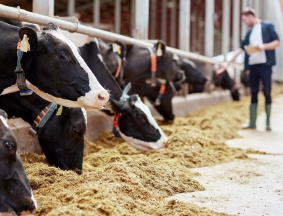Does a calculated ration actually produce the milk production as expected? Until recently, this only became clear after a few weeks, when milk production lagged behind or the health of the cows declined. In the meantime, you may have already made a few ration adjustments and had disappointing results.
Ration Check brings an end to these woes. By analysing the mixed ration, you will know whether the calculated values are actually at the feed fence. Thanks to NIRS analysis, it is possible to obtain a lot of information about the composition of mixed rations and silages at a low cost. The mineral analyses are performed chemically. As it is not possible to calculate feed values reliably, these are not reported.
Sampling
The sample should be a good reflection of the total ration. You should therefore take a quantity of about 1-1.5 kg in one go. If the mixture is well mixed, this will give a good impression. Put this mixture directly into a plastic bag; do not collect the sample in a bucket first, as this can cause it to separate, as products such as soy will often remain at the bottom of the bucket. Squeeze all of the air out of the bag and manipulate it into a round, hard ball, then seal it tightly and ship the sample.

